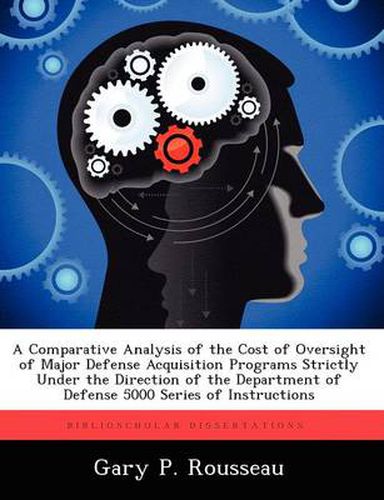Readings Newsletter
Become a Readings Member to make your shopping experience even easier.
Sign in or sign up for free!
You’re not far away from qualifying for FREE standard shipping within Australia
You’ve qualified for FREE standard shipping within Australia
The cart is loading…






This title is printed to order. This book may have been self-published. If so, we cannot guarantee the quality of the content. In the main most books will have gone through the editing process however some may not. We therefore suggest that you be aware of this before ordering this book. If in doubt check either the author or publisher’s details as we are unable to accept any returns unless they are faulty. Please contact us if you have any questions.
The United States Department of Defense has been caught in a continual cycle of acquisition reform since its inception over two hundred years ago. The goal of acquisition reform has always been to find the perfect balance between the amount of program oversight and the amount of flexibility in which program managers are allowed to manage their programs. The only truth learned throughout this process is that defense acquisition does need oversight and that there is no cookie cutter pattern for oversight that will fit all types of acquisition programs equally well. That being said, the focus of this thesis will be to explore the foundations of oversight for programs following Department of Defense Directive 5000-the defense acquisition bible and employ Delphi survey techniques to then develop an estimate for the actual cost of oversight for defense acquisition programs that are under the guidance of the DoDD 5000. The real value in this research will then be to compare the oversight cost estimate for programs under the DoDD 5000 to oversight cost estimates developed using the exact same methodology but examining programs with different types of oversight. Specifically, space acquisition and communications acquisition have been operating under a different oversight format over the last few years and the interest is in determining if the changes have made defense acquisition any more efficient and any less costly.
$9.00 standard shipping within Australia
FREE standard shipping within Australia for orders over $100.00
Express & International shipping calculated at checkout
This title is printed to order. This book may have been self-published. If so, we cannot guarantee the quality of the content. In the main most books will have gone through the editing process however some may not. We therefore suggest that you be aware of this before ordering this book. If in doubt check either the author or publisher’s details as we are unable to accept any returns unless they are faulty. Please contact us if you have any questions.
The United States Department of Defense has been caught in a continual cycle of acquisition reform since its inception over two hundred years ago. The goal of acquisition reform has always been to find the perfect balance between the amount of program oversight and the amount of flexibility in which program managers are allowed to manage their programs. The only truth learned throughout this process is that defense acquisition does need oversight and that there is no cookie cutter pattern for oversight that will fit all types of acquisition programs equally well. That being said, the focus of this thesis will be to explore the foundations of oversight for programs following Department of Defense Directive 5000-the defense acquisition bible and employ Delphi survey techniques to then develop an estimate for the actual cost of oversight for defense acquisition programs that are under the guidance of the DoDD 5000. The real value in this research will then be to compare the oversight cost estimate for programs under the DoDD 5000 to oversight cost estimates developed using the exact same methodology but examining programs with different types of oversight. Specifically, space acquisition and communications acquisition have been operating under a different oversight format over the last few years and the interest is in determining if the changes have made defense acquisition any more efficient and any less costly.